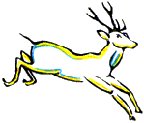 |
Tth'ėn(Dėne)
Acâhkosak(Cree)
The Night Sky
|
 |
|
Shaun Nagy
La Loche Community School
La Loche, SK, Canada
Rekindling Traditions
Cross-Cultural Science and Technology Units (CCSTU)
Series Editor
Glen Aikenhead
University of Saskatchewan
Saskatoon, SK, Canada
CURRICULUM CONNECTION
Grades 8-11 astronomy
OVERVIEW
Aboriginal cosmology is validated through learning about the night sky from an Aboriginal point of view. This provides the context for learning astronomy concepts from Western science. Both knowledge systems, Aboriginal and Western, are explicitly acknowledged. Experiential learning is highlighted in both domains in this unit. Duration: about 2 to 3 weeks.
PURPOSE
This unit is designed to enrich students' understanding and appreciation of Aboriginal science and Western science in the area often called astronomy, and to encourage students to continue their studies in school science in the future. The unit offers experiences for students to practice thinking in two worlds -- the world of Aboriginal culture and the world of Western culture; thereby helping students feel more comfortable using ideas they may not believe themselves, but ideas they nevertheless can certainly understand and use to converse with others.
GOALS
- To develop confidence in interviewing elders, working independently, understanding Western science, and expressing personal ideas and beliefs.
- To gain knowledge of both Aboriginal and Western science concepts about the night sky.
- To appreciate the wealth of knowledge held by elders of different cultures.
- To become familiar with technologies such as calendars, internet, lenses, and telescopes.
- To appreciate that the circle of life extends beyond the earth.
- To answer students common curiosities about the night sky.
- To develop a habit of keeping up to date on current discoveries in the universe.
- To get students to interact with their environment and their community.
- To introduce students to career possibilities related to science and engineering.
OBJECTIVES
- Students will develop their listening and remembering skills.
- Students will learn how the year is divided into 13 moons, according to observable events related to the Moon; or can be divided into 12 months, according to assumptions about base 12 in mathematics.
- Students will learn the 13 moons in Dëne and their English translation.
- Students will analyse visual evidence about the Moon and make inferences about its motion around the Earth.
- Students will be able to describe or role play the counter clockwise motions of the rotation of the Earth, the revolution of the Moon around the Sun, and the revolution of the Earth/Moon around the sun.
- Students will be able to explain how we see various phases of the Moon at different times, and explain the infrequency of lunar and solar eclipses.
- Students will remember key aspects of our universe from the Western science cultural point of view.
- Students will be able to describe how a telescope works, including such features as: (a) refraction of light, (b) focal length, (c) the equation: magnification = fp/fe
- Students will write a short newspaper article for the Pisa Press about Galileo.
- Students will describe one mystery about the night sky.
- Students will appreciate various chemical, astronomical, physical, and biological factors that sustain life on our planet.
- Students will describe evidence for the historical interest in the shape of the Earth.
- Students will remember reasons for the view that the Earth is basically spherical.
- Students will be able to explain the phenomena of twinkling and falling stars.
- Students will collect evidence of meteoroids, and wonder where the material came from.
- Students will remember that only 3 metals (iron, nickel, and cobalt) interact with a magnet.
- Students will remember the type of matter that makes up plasma (positively and negatively charged fundamental particles: protons, electrons, etc.).
- Students will be able to repeat the science story of northern lights.
- Students will be able to describe one interesting feature of each planet in our solar system, and about the Sun.
LESSONS
- Interview With an Adult
- The Calendar is Made
- The Earth's Moon
- The Universe
- Seeing Through a Telescope
- Life on Earth
- The Spherical Earth
- Why do Stars Twinkle?
- Falling Star Scavenger Hunt
- The Birth/Death Cycle of Stars
- The Northern Lights
- A Quick Tour of Our Solar System
- Review
Appendix A Aboriginal Calendars
Appendix B A Short History of Calendars
.......................................................................................................
Download (Non-editable)
You may download this file in PDF format by clicking the Adobe PDF icon below.
You will need the Adobe Acrobat Viewer to access this file. If you do not have
it installed on your system, get it here: 
Order By Mail (Editable)
To obtain the file in Microsoft Word 97 format, order the Rekindling
Traditions CD from:
Northern Lights School Division
Teacher Resource Department
Bag Service 6500
La Ronge, SK S0J 1L0
(306)425-3302
[ Units Menu ]




![]()